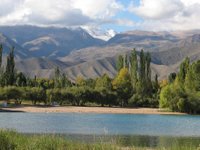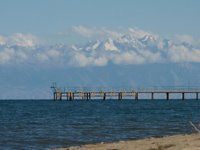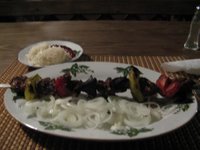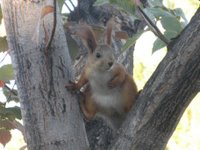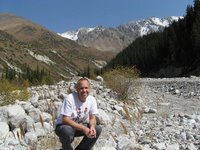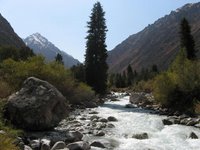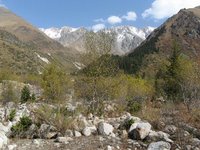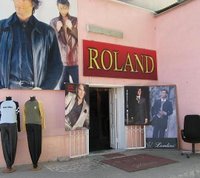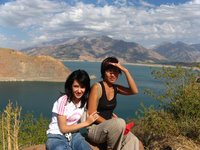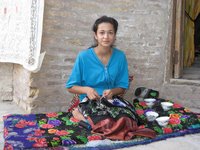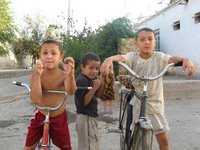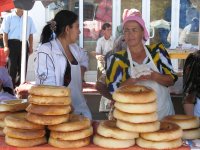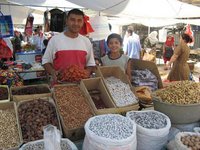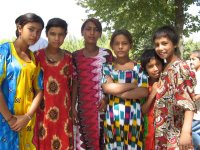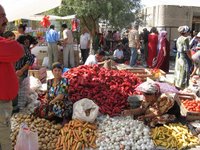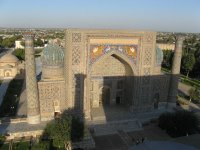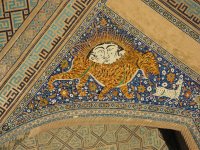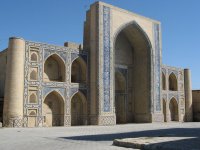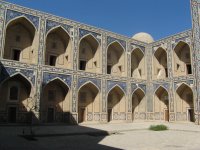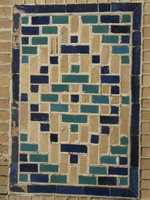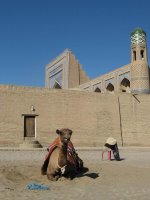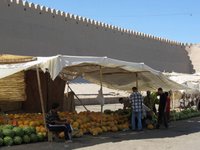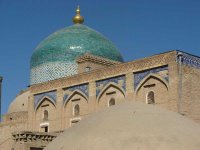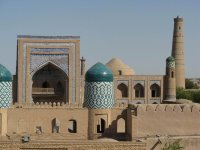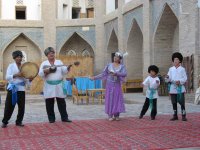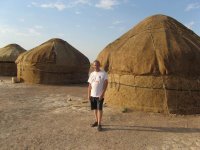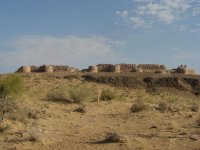Leaving Tashkent I had 2 days to get to Kyrgyzstan before my visa expired, it is not straight forward so I left enough time. There are no buses going this way except for one which goes via Kazakhstan, which requires a transit visa, so not worth doing that. The train goes via Tajikistan and apparently does not require a transit visa, that was a good option, except it only runs once a week on thursdays, so that was also out of the question. So, the only option was a shared taxi. At the train station I found a group of Fergana bound taxis, about 7 or 8 cars, but only one passenger, well they don't normally have to wait long I was told. Two hours later it was still only the one lady in the car and me, guess this could have taken a while. But then, luckily, one driver (who had only recently appeared) offered me a lift in a solo taxi at no extra cost ! After arguing with the driver whose car my baggage was in, they agreed I could go with him. He could only take one passenger anyway as the car was full of merchandise which we then delivered on the way, but at least I got going. I felt sorry for the woman who was still waiting and wondered why she was not offered the lift first, I can only assume that despite my hard nosed haggling, the price they wanted from me was still a little higher than what locals were paying. I wonder what time she got away, if ever.

The road to the Fergana valley crossed through mountains with wonderful views (expect for the large advertisements painted on hillsides), the roads were pretty busy and everyone was in a rush, at times there was double overtaking taking place while cars approached in the other direction on a road just wide enough for two cars! The rubble lined tracks alongside the roads were frequently used for undertaking too ! Chaotic. I noticed after any close shave my driver running his hand over his face, an islamic act, signifying thanks to Allah. But we arrived safely and early evening in the town of Fergana, there did not seem to be much there, a few loud cafes, and people selling food anywhere on the streets was all that caught my attention. After some dinner and a particularly nasty half litre of beer (cost 500 som which is about $0.40, it's true, you do get what you pay for) I tried to sleep with loud Uzbek and Turkish music screaming out in the cafe outside my hotel, eventually I did.
The next morning I found out where to get transport to Kyrgyzstan, I had two options on which direction to go, the easy one to Osh, which meant a long 15 hour journey to bishkek, or a not much further, but unknown route, trip to the border at Uchkurgan, which would knocka few hours off the journey time to Bishkek, though admittedly it would not be so easy to move onwards from there, so could end up taking longer. I had opted for the easier Osh option until I met 2 french guys I had seen previously in Samarkand, they were going via Uchkurgan. So, I decided also to go that way thinking I may catch up with them later. I got a mashroetnoe minibus to Andijan no problem, there I was told a bus goes to Uchkurgan at 13:25, nice. an hour later i was told the bus would not run today, there maybe one at 15:00, alternatively go to Namagan and take a mini bus form there. To keep moving i did this. Speaking to a lady on the bus, she chatted to some man who agreed to show me where to get off and get a minibus to another stop where i can get another minibus to Uchkurgan, it all went ok. On the last of these mini-buses which flew through the streets like it was a rally event, some old ladies started talking to me and got excited about the foreigner on board, they were going into the town of Uchkurgan and offered me a place in their taxi, which was nice, no problems. Centre of town, found a taxi to the border, got to the border and it's closed !!! No international crsossing apparently, gates were closed and it looked very closed, though some cars were occassionaly coming through, but they weren't going to let me through anyway. So by now it was 16:15 or so, taxi back to Uchkurgan, no buses from here to Andijan, so get a taxi to Andijan which wound through country lanes swerving and braking regularly to avoid cows, sheep or dogs, another taxi to the border at Dostlik and eventually into Kyrgyzstan after about 12 hours on various mashroetnoe buses, proper buses, taxis, mini-buses and some walking across the border and still with a couple of hours left on my visa !! In the final taxi of the day to Osh, I shared with Fatima who seemed to be a friend of the driver, the driver was excited when he found my age and that I was single as I seemed a very good match for Fatima and he jokingly (I hope) offered her to me as a potential wife, she didn't argue too much, so maybe she was interested actually ! I don't know but I politely declined and went to my hotel for what I hope would be a good sleep.

Through most of Fergana valley, you see field after field of cotton plants, a sight not familiar to Europeans, with a few fields of rice, wheat, and fruit trees, scattered in between it's a very green area of the country. I later found out that this is government influenced, farmers have to allocate a percentage of their arable land to growing cotton, from which they get poor profits. This is just one of the many controls that appear to be put on Uzbek people by their government.

One of the many good things about Uzbekistan is that it is - to me anyway - the land of melons, probably my favourite fruit. Wherever yo go there are all varieties of melons and watermelons available at all times of day. Along the roadsides you see stall after stall of melons for sale at pretty reasonable prices, at markets there are more melons than you can possibly imagine and in most of the guesthouses I stayed in, after agreeing on a price, the host will invariably bring you a pot of green tea and some melon...Excellent


